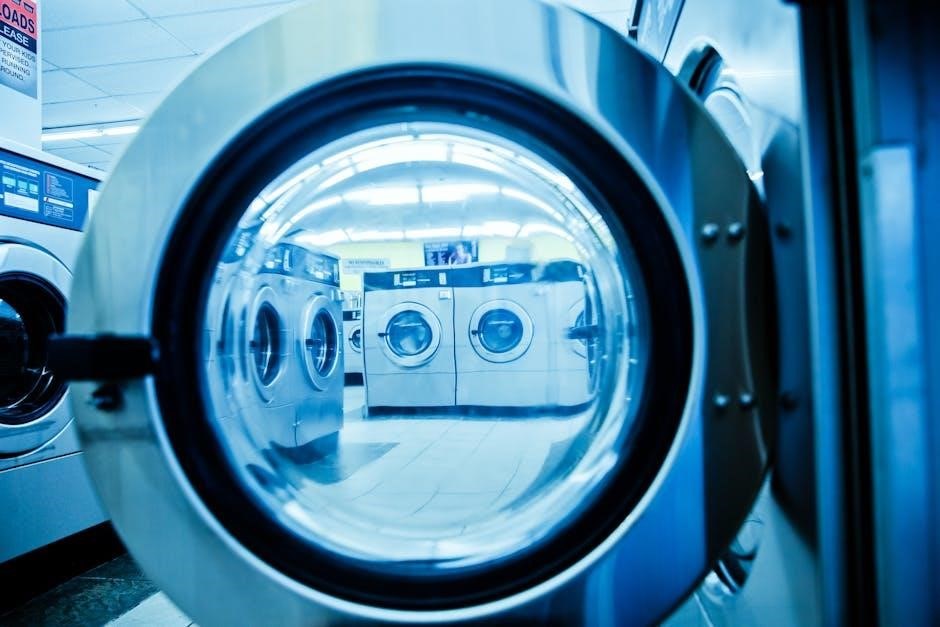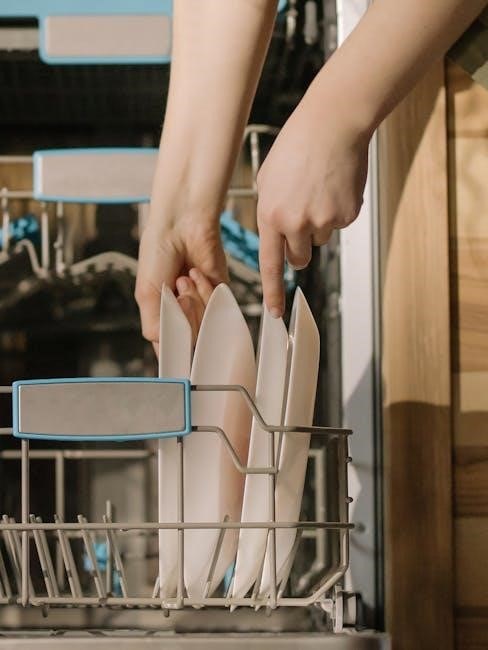crosley washer manual
Summary
Get the comprehensive Crosley washer manual! Easy-to-follow instructions, troubleshooting tips, and maintenance advice. Download now and keep your appliance running smoothly.

This manual provides a comprehensive guide for Crosley washer users, covering installation, operation, and maintenance. It ensures safe, efficient, and effective use of your appliance, helping you understand its features and troubleshoot common issues for optimal performance and longevity.
1.1 Overview of Crosley Washer Models
Crosley offers a range of washer models designed to meet various household needs. From top-load to front-load designs, these appliances are known for their reliability and durability. Each model features advanced technologies like multiple wash cycles, energy efficiency, and quiet operation. Whether you prefer classic designs or modern smart-enabled washers, Crosley provides options to suit different preferences and lifestyles. Understanding your specific model is key to maximizing its performance and longevity. This section helps you identify your Crosley washer model and its unique features, ensuring you make the most of its capabilities.
1.2 Importance of Reading the Manual
Reading the Crosley washer manual is essential for understanding its operation, safety features, and maintenance requirements. It ensures you use the appliance correctly, avoiding potential damage or safety risks. The manual provides detailed instructions for installation, troubleshooting, and optimal use of features. By familiarizing yourself with the guide, you can maximize the washer’s performance, extend its lifespan, and resolve common issues efficiently. It also highlights energy-saving tips and maintenance schedules, helping you make the most of your investment. Ignoring the manual may lead to misuse, which could void the warranty or cause unnecessary repairs. Always refer to it for guidance.
1.3 Key Features of Crosley Washers
Crosley washers are known for their advanced features, including multiple wash cycles, energy efficiency, and quiet operation. Many models offer large capacity drums, allowing for bigger loads. They often include smart sensors that detect load size and balance, optimizing water and energy use. Some units feature steam cleaning options for deeper sanitization. Additionally, Crosley washers are designed with user-friendly controls and durable construction for long-lasting performance. These features ensure efficient, reliable, and eco-friendly laundry care, making Crosley a trusted choice for modern households seeking convenience and sustainability in their appliances.

Installation and Setup
Proper installation ensures optimal performance. Place the washer on a level surface, connect water supply lines, and secure the drain hose. Follow manual guidelines carefully.
2.1 Pre-Installation Requirements
Before installing your Crosley washer, ensure the space is prepared. Choose a flat, stable surface away from direct sunlight and moisture. Verify the floor can support the washer’s weight when loaded. Ensure nearby access to a 120V electrical outlet, water supply lines, and a drainage system. Measure the space to confirm the washer fits comfortably. Check for any obstructions and ensure the area is clear. Review the manual for specific dimensional requirements and compatibility with your plumbing setup. Prepare all necessary tools and parts provided with the washer for a smooth installation process.
2.2 Step-by-Step Installation Guide
Carefully unpack the Crosley washer from its packaging, ensuring all components are included and undamaged.
Place the washer on a level, sturdy surface in your prepared location.
Connect the water supply hoses to both the washer and your home’s water supply lines, ensuring they are securely tightened.
Attach the drainage hose to the washer and direct it into a nearby drain or laundry sink.
Plug the power cord into a nearby 120V outlet, ensuring it is easily accessible.
Double-check all connections for leaks and proper alignment.
Test the washer by running a short cycle to ensure everything operates smoothly.
2.3 Connecting Water and Drainage
Connect the water supply lines to the washer’s inlet valves, ensuring they are securely tightened. Use Teflon tape on threaded connections to prevent leaks. Attach the drainage hose to the washer’s drain port and direct it into a nearby standpipe, laundry sink, or drainpipe. Ensure the drainage hose is not kinked or blocked. For a standpipe, maintain a minimum height of 30 inches and a maximum of 8 feet to prevent siphoning. Check all connections for leaks before powering on the washer. Proper water and drainage connections are crucial for efficient operation and to avoid water damage or flooding.

Operating the Washer
Start by selecting the desired wash cycle, add detergent, and load clothes. Ensure balanced loading, close the lid, and press Start. Monitor progress via the timer and sensors.
3.1 Understanding the Control Panel
The control panel is the central interface for operating your Crosley washer. It features a user-friendly layout with buttons, knobs, and a digital display. The power button turns the washer on/off, while cycle selection buttons allow you to choose between options like Normal, Heavy Duty, or Delicates. Additional buttons enable temperature adjustments, spin speed, and special features like Steam Clean or Sanitize. The digital display shows the selected cycle, estimated time, and status updates. LED indicators highlight active modes, ensuring clear operation. Familiarizing yourself with these elements ensures efficient and tailored washing cycles for optimal fabric care.
3.2 Normal Wash Cycle Instructions
To start a normal wash cycle, press the Power button and select the desired cycle using the Cycle Selector. Choose options like Normal, Casual, or Heavy Duty based on fabric type and soil level. Select temperature (Hot, Warm, Cold) and spin speed (Low, Medium, High). Add the recommended amount of detergent to the dispenser. Load clothes, ensuring balanced distribution. Close the lid and press Start. The washer will automatically fill with water, wash, rinse, and spin. Monitor progress via the digital display. For optimal results, avoid overloading and ensure proper fabric sorting. Let the cycle complete for best cleaning outcomes.
3.3 Special Wash Cycles and Options
The Crosley washer offers specialized cycles for specific needs. The Delicate cycle gently cleans fragile fabrics, while the Heavy Duty cycle tackles heavily soiled items. The Quick Wash option speeds up the cycle for lightly soiled loads. Additional features include Steam Clean to sanitize and reduce odors, and Sanitize for deep cleaning; You can also customize settings with options like Pre-Wash, Extra Rinse, and Fabric Refresh. Use the control panel to select these cycles and options, ensuring optimal care for your laundry. Always refer to the manual for specific button combinations and cycle details to maximize performance.

Maintenance and Care
Regular maintenance ensures optimal performance. Clean the gasket, check hoses, and run a cleaning cycle. Schedule annual professional checks to maintain efficiency and extend lifespan.
4.1 Cleaning the Washer Regularly
Regular cleaning is essential for maintaining your Crosley washer’s performance. Start by wiping down the exterior with a damp cloth. For the interior, run a cleaning cycle using vinegar or a washer cleaner. Remove and clean the detergent dispenser and gasket, as buildup can cause odors. Check the drain pump filter and clean it if necessary. Leave the lid open after use to dry the interior and prevent mildew. Cleaning regularly prevents mold, odors, and residue buildup, ensuring fresh and efficient washes; Always refer to your manual for specific cleaning recommendations tailored to your model.
4.2 Checking and Replacing Parts
Regularly inspecting and replacing worn parts ensures your Crosley washer operates efficiently. Check the hoses for cracks or leaks and replace them every 5 years. Inspect belts for wear and tear, replacing them if damaged. Seals and gaskets should be examined for signs of deterioration. If you notice vibrations or unusual noises, check the balance and level of the washer. Always turn off power before performing inspections. Refer to your manual for specific part locations and replacement instructions. Use genuine Crosley parts for reliability. Routine checks can prevent costly repairs and extend the lifespan of your appliance.
4.3 Regular Maintenance Schedule
Establishing a maintenance routine ensures your Crosley washer performs optimally. Clean the gasket and detergent dispenser monthly to prevent mold buildup. Every 3 months, check and clean the drain pump filter to maintain proper drainage. Run a cleaning cycle with a washer cleaner or vinegar to remove residue. Annually, inspect hoses for cracks and belts for wear. Ensure the washer is balanced to prevent vibrations. Refer to your manual for specific intervals. Following this schedule helps prevent breakdowns, maintains efficiency, and extends the appliance’s lifespan. Consistency is key to keeping your Crosley washer in excellent working condition.

Troubleshooting Common Issues
This section helps identify and resolve common problems with your Crosley washer, such as error codes, noise issues, or drainage problems, ensuring efficient appliance operation.
5.1 Identifying Common Problems
Common issues with Crosley washers include the machine not starting, excessive noise, vibration, or water not draining properly. These problems often stem from improper installation, unbalanced loads, or clogged drainage hoses. Additionally, error codes may indicate specific faults, such as sensor malfunctions or overheating. Regularly checking for blockages, ensuring balanced loads, and monitoring detergent usage can prevent many of these issues. If problems persist, consulting the manual or contacting customer support is recommended to avoid further damage. Early identification of these problems helps maintain the washer’s performance and longevity, ensuring reliable operation for years to come.
5.2 Error Codes and Solutions
Crosley washers display error codes to indicate specific issues. Common codes include E1 (water level sensor malfunction), E2 (drainage problem), and E3 (overheating). For E1, check the water level sensor or ensure the tub is level. If E2 appears, inspect the drain hose for kinks or blockages and ensure proper installation. For E3, allow the washer to cool down and verify ventilation. Always refer to the manual for code meanings and step-by-step solutions. Addressing these issues promptly prevents further damage and ensures optimal performance. Regular maintenance can help minimize error occurrences and extend the washer’s lifespan.
5.3 Resetting the Washer
To reset your Crosley washer, unplug it from the power source and wait for 30 minutes to allow the internal systems to reset. Plug it back in and select a normal cycle to test if the issue is resolved. If the problem persists, check for error codes or consult the manual. Resetting can resolve minor glitches or software-related issues. For more severe problems, contact customer support or an authorized technician. Regular resets can help maintain optimal performance, but ensure proper diagnosis to avoid recurring issues. Always follow safety guidelines when handling electrical appliances.

Safety Precautions
Always unplug the washer before servicing. Avoid overloading, as it can cause imbalance. Keep children away from moving parts. Never use excessive detergent, and avoid contact with sharp edges. Ensure proper ventilation and follow all safety guidelines to prevent accidents and ensure safe operation.
6.1 Important Safety Tips
Safety is crucial when operating your Crosley washer. Always keep children away from the appliance and ensure they cannot access the control panel or moving parts. Avoid overloading the washer, as this can lead to imbalance and potential damage. Never lean or stand on the washer, and ensure it is installed on a stable, level surface. Use only recommended detergents and avoid excessive use to prevent suds overflow. Keep the area around the washer clear of clutter and ensure proper ventilation. Regularly inspect hoses and connections for signs of wear. Always unplug the washer before performing any maintenance or repairs.
6.2 Handling Emergencies
In case of an emergency, such as the washer not turning off or water leakage, act quickly to prevent damage. First, unplug the washer from the power outlet to stop all functions. If water is leaking, turn off the water supply valves immediately. Do not attempt to drain the washer yourself, as this could cause further issues. For a washer that won’t stop running, press the Cancel or Stop button and unplug it. Never attempt repairs yourself, especially if water is involved. Contact a licensed technician or Crosley customer support for assistance. Always prioritize safety to avoid accidents or electrical hazards.
6.3 Child Safety Features
Crosley washers include child safety features to prevent accidents. The child lock function ensures buttons cannot be pressed accidentally, avoiding unintended cycle changes. The lid is designed to stop operation if opened, protecting children from moving parts. Additionally, the washer’s stable design reduces tipping risks. Always supervise children near the washer and teach them its dangers. Store detergent out of reach to prevent ingestion. Regularly check for loose parts and secure them. These features promote a safer environment, but adult supervision remains crucial for child safety while operating the appliance.

Energy Efficiency and Environmental Impact
Crosley washers are designed with energy efficiency in mind, featuring Energy Star certification and eco-friendly cycles that reduce water and electricity usage. These models promote sustainable practices, lowering environmental impact while maintaining performance. By using less energy and water, Crosley washers help consumers reduce their ecological footprint. This section highlights the importance of energy-efficient appliances and their role in environmental conservation. Making eco-conscious choices with Crosley washers supports a greener future without compromising on cleaning effectiveness.
7.1 Energy-Saving Features
Crosley washers are equipped with advanced energy-saving technologies to minimize power consumption. Key features include Energy Star certification, eco-mode cycles, and adaptive sensors that optimize water and energy use. The eco-mode reduces energy by up to 30% compared to standard cycles. Additionally, the washer uses low-power motors and smart temperature control to further conserve energy. These features ensure efficient performance while lowering utility bills and reducing environmental impact. By incorporating these technologies, Crosley washers provide a sustainable solution for everyday laundry needs.
7.2 Reducing Water Consumption
Crosley washers are designed with water-saving technologies to reduce consumption. Advanced sensors detect load size and soil level, optimizing water usage. Low-water wash cycles are available for smaller loads, minimizing excess water. The washer also features automatic shut-off to prevent overflow. Energy Star certification ensures water efficiency alongside energy savings. Regular maintenance, like checking hoses for leaks, further prevents water waste. By using high-efficiency detergent, water usage is optimized. These features help conserve water while maintaining cleaning performance, supporting eco-friendly laundry practices and lowering utility bills.
7.3 Eco-Friendly Washing Practices
Crosley washers support eco-friendly practices through energy-efficient designs. Using cold water cycles reduces energy consumption and preserves fabric quality. Selecting the eco-mode minimizes water and detergent use. High-efficiency detergent is recommended for optimal performance and environmental benefits. Energy Star certification ensures the washer meets eco-friendly standards. Regularly cleaning the filter improves efficiency and reduces water waste. Properly loading the washer prevents overuse of resources. By following these practices, users can significantly reduce their environmental impact while maintaining effective cleaning results. Eco-conscious habits extend the washer’s lifespan and contribute to a greener household.

Warranty and Customer Support
Crosley washers come with a comprehensive warranty covering parts and labor for up to 1 year; Register your product for warranty validation and exclusive benefits. Contact customer support via phone, email, or the official website for assistance.
8.1 Understanding the Warranty
Crosley washers are backed by a limited warranty that covers defective parts and labor for a specified period, typically 1 year from purchase. This warranty applies to original purchasers and ensures repairs or replacements at no cost for factory defects. Coverage excludes damage from misuse, neglect, or unauthorized repairs. To maintain warranty validity, users must follow the manual’s guidelines and register their product. Warranty terms vary by model, so reviewing the provided documentation is essential. Extended warranties may be available for additional protection. Always contact Crosley support for warranty-related inquiries or claims.
8.2 Contacting Customer Support
To contact Crosley customer support, visit their official website for contact details. Most models include a support phone number and email address in the manual. Additionally, Crosley’s website often features a contact form or live chat option for assistance. When reaching out, have your washer’s model and serial number ready for faster service. Support agents are typically available Monday through Friday, 9 AM to 5 PM EST. For troubleshooting or repair needs, provide detailed information about the issue. Keep your manual handy, as it may contain specific instructions or codes needed for support. Prompt assistance is available for warranty and non-warranty inquiries.
8.3 Finding Authorized Service Centers
To locate an authorized Crosley service center, visit the official Crosley website and navigate to the “Where to Buy” or “Service Centers” section. Enter your zip code or city to find nearby centers. You can also contact Crosley customer support directly for a list of authorized providers in your area. Ensure the service center is authorized to maintain your warranty coverage. Keep your washer’s model and serial number handy for faster assistance. Always verify the center’s authorization before scheduling service to ensure genuine parts and reliable support;

Additional Tips for Optimal Use
Always check pockets for loose items, sort clothes by fabric type, and use the right detergent dosage. Clean filters regularly to ensure proper water flow and prevent clogs. Avoid overloading the washer for better cleaning efficiency and to reduce wear on the machine. Regularly inspect belts and hoses for signs of wear to maintain optimal performance. Following these tips will help extend the life of your Crosley washer while ensuring your clothes are cleaned thoroughly and gently.
9.1 Loading the Washer Correctly
Proper loading ensures optimal performance and prevents damage. Sort clothes by fabric type and color to avoid damage or discoloration. Do not overload the washer, as this can reduce cleaning efficiency and cause imbalance during spinning. Balance the load evenly, distributing heavier and bulkier items like towels or jeans evenly around the drum. Avoid overstuffing, as this restricts water flow and agitation. Place delicate or fragile items in a mesh laundry bag for protection. Always follow the recommended load capacity specified in your Crosley washer manual to ensure smooth operation and extend the appliance’s lifespan.
9.2 Using the Right Detergent
Using the correct detergent ensures optimal cleaning and maintains your Crosley washer’s performance. Choose a high-efficiency (HE) detergent, as it produces fewer suds and is designed for modern washers. Avoid using too much detergent, as excess residue can build up inside the machine. Measure detergent according to the manufacturer’s guidelines, typically 1-2 tablespoons per load. For tough stains, pre-treat clothes before washing. Always check the detergent’s compatibility with your washer’s settings and water temperature. Using the right detergent enhances cleaning efficiency, prevents damage, and extends the lifespan of your Crosley washer. Avoid generic or low-quality detergents that may not rinse thoroughly.
9.3 Maximizing Wash Performance
To maximize your Crosley washer’s performance, ensure proper load balancing and avoid overloading. Sort clothes by fabric type and weight to prevent damage and ensure even cleaning. Use the appropriate cycle and settings for the load, such as delicate or heavy-duty options. Keep the washer clean by running a cleaning cycle regularly. Check for blockages in the drain pump and ensure proper ventilation around the unit. Regularly inspect and clean the gasket and detergent dispenser. Proper maintenance and usage habits will extend the washer’s lifespan and improve its efficiency. Always refer to the manual for specific care and optimization tips.

Upgrading or Replacing the Washer
If your Crosley washer shows signs of wear or outdated features, consider upgrading to a newer model for improved performance and energy efficiency. Always consult the manual or contact the Crosley support team for guidance on replacement options and compatibility. Proper disposal of your old washer is essential for environmental protection. Research newer models that align with your needs and budget for a seamless transition to a better washing experience. Upgrading ensures you benefit from the latest technology and enhanced reliability. Plan accordingly to minimize downtime during the replacement process. Ensure to purchase from authorized dealers for genuine products and valid warranties. Evaluating your current washer’s condition and comparing it with newer models can help you make an informed decision. Additionally, consider the cost of repairs versus the cost of a new washer to determine the most economical choice. Always follow the manufacturer’s guidelines for disposal to contribute to sustainable practices. Finally, take advantage of any available promotions or discounts when purchasing a new Crosley washer to maximize your investment. By doing so, you can enjoy improved washing performance and long-term savings on energy and maintenance costs.
10.1 Signs You Need a New Washer
If your Crosley washer requires frequent repairs, is noisy, or vibrates excessively, it may be time to consider replacement. Leaks, poor performance, or longer cycle times are additional indicators. If energy bills rise or cleaning effectiveness declines, a new model could be more efficient. Rust, corrosion, or outdated technology are also signs. Consider upgrading if your washer no longer meets your household’s needs or lacks modern features. Replace it if repair costs exceed half the price of a new unit. Addressing these issues early ensures reliability and prevents further damage. A new washer can provide better performance, efficiency, and convenience.
10.2 Upgrading to a New Model
When upgrading to a new Crosley washer, consider newer models with advanced features like smart technology, larger capacities, or energy-efficient designs. Research models that align with your needs, such as steam cleaning or sanitizing cycles. Compare features, read reviews, and check warranty options. Ensure the new model is compatible with your existing plumbing and electrical setup. Purchase from authorized dealers to avoid counterfeit products. Plan for professional installation to ensure proper setup and functionality. Upgrading can enhance performance, reduce energy consumption, and provide modern convenience. Always follow Crosley’s guidelines for disposing of your old appliance responsibly. This ensures eco-friendly practices and safety.
10.3 Proper Disposal of Old Appliances
Disposing of your old Crosley washer responsibly is crucial for environmental protection. Check local regulations for appliance disposal, as many areas have specific guidelines. Consider donating the washer if it’s still functional or selling it secondhand. If it’s no longer usable, look for e-waste recycling centers or appliance recycling programs that accept large appliances. Many retailers and manufacturers offer take-back programs for old appliances. Ensure hazardous materials like batteries or electronic components are handled appropriately. Proper disposal prevents harmful substances from entering landfills and supports eco-friendly practices. Always follow community guidelines and aim for recycling over landfill disposal.